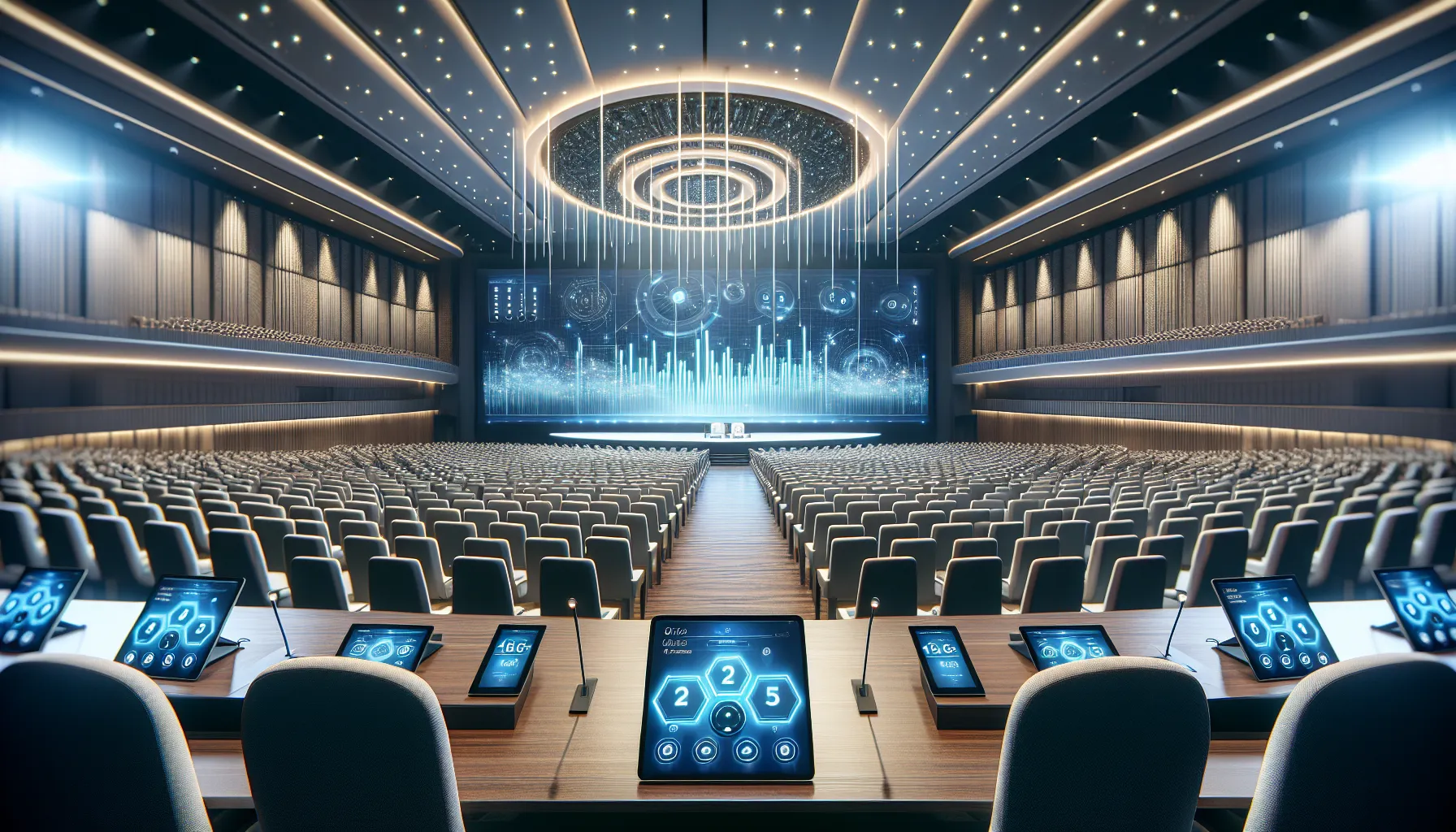How Does Technology Enhance Attendee Engagement at Conferences?
In the digital age, technology has become a pivotal tool in transforming the conference experience for attendees. We’ve gathered insights from Chief Technology Officers to marketing managers, revealing the most innovative ways to enhance engagement. From revolutionizing attendee involvement with VR to fostering connections through event applications, explore the diverse strategies in these twelve expert contributions.
- Revolutionize Engagement with VR
- Challenges Boost Conference Interaction
- Interactive Polling Invigorates Sessions
- QR Codes Simplify Networking
- Simple Gamification Engages Attendees
- AI Chatbots Personalize Assistance
- Second-Screen Experience Deepens Participation
- Mobile Apps Centralize Conference Info
- Touchless Tech Invites Global Participation
- Interactive Apps Personalize Conference Experience
- Event-specific Applications Foster Connections
- Feedback Encourages Audience Participation
Revolutionize Engagement with VR
Immersive experiences with VR technology have revolutionized the way we interact with digital content. From the moment you put on the headset, you are transported to a whole new world, with unparalleled levels of immersion and realism. VR has the power to simulate real-world scenarios, provide hands-on learning experiences, and connect people from all over the world.
 Rubens Basso
Rubens Basso
Chief Technology Officer, FieldRoutes
Challenges Boost Conference Interaction
Technology has significantly boosted attendee engagement at conferences through gamification. Interactive games and challenges encourage active participation, making sessions more stimulating and fostering networking among attendees. Moreover, gamification serves as a valuable tool for gathering data and feedback, enabling more personalized experiences in future events.
Overall, gamification injects fun and excitement into conferences, creating memorable and engaging experiences for all participants. It’s a pivotal method for enhancing attendee engagement at conferences.
 Alex Taylor
Alex Taylor
Head of Marketing, CrownTV
Interactive Polling Invigorates Sessions
In my journey founding Traverse, which focuses on enhancing learning through technology, I’ve witnessed how tech can transform engagement, not just in the classroom but also at conferences. One particularly effective technology we’ve utilized is the integration of interactive polling and Q&A sessions directly within presentations. This approach, leveraging platforms similar to our learning tool, invites real-time feedback and participation from the audience, making the experience more dynamic and inclusive. It turns passive listeners into active participants, greatly enhancing the overall engagement and effectiveness of the sessions.
Another avenue where I’ve seen technology elevate attendee engagement at conferences is through the use of virtual reality (VR) and augmented reality (AR) showcases. For instance, at a learning tech conference, we introduced an AR app that allowed users to visualize complex concepts in 3D space right on their smartphones. This not only captivated attendees with a novel experience but also facilitated a deeper understanding of the subjects being discussed. The immersive nature of VR and AR can transform abstract concepts into tangible experiences, making the learning and engagement process much more impactful.
Lastly, personalization powered by AI has been a game changer. Just as we use AI in Traverse to tailor learning experiences, conferences are now using similar technologies to provide personalized agendas, networking opportunities, and content recommendations for each attendee. This level of customization ensures that every participant can maximize their time and engagement based on their individual interests and goals.
By employing technology that adapts to the user, conferences can create more meaningful and engaging experiences that resonate on a personal level with attendees, transforming how information is shared and absorbed.
 Dominic Zijlstra
Dominic Zijlstra
Founder, Adaptify AI
QR Codes Simplify Networking
An innovative strategy I have noted for utilizing technology to improve conference engagement is the development of QR codes for registrants. These QR codes are fused onto the badges participants wear throughout the entirety of the conference and include essential information like the individual’s name, personal contact information, and other details. The tradition of exchanging business cards when meeting someone new and wanting to retain contacts is redundant.
These days, as we meet someone, our first thought is, “What’s your online identity?” Rather than pulling out a business card and relying on the other person to add your contact information later, you can rapidly exchange contact details directly from your smartphones. This ensures you don’t lose touch and makes follow-ups just that much easier. The QR codes are a more practical, contemporary, and indispensable solution to traditional challenges between attendees at conferences.
 Blake Smith
Blake Smith
Marketing Manager, ClockOn
Simple Gamification Engages Attendees
I’ve seen some very impressive bits of gamification at major conferences in the last few years, with some of the simplest being the most effective. One that I’ve seen a few times now is that a booth will include a code for a short two- or three-question quiz, which will net you a finer bit of conference kit than just the standard freebies.
I’ve also seen one that lets you put in a guess for a question with a very wide range, and the person getting closest to it at the end would win a prize or recognition from the booth in question. These things are fairly simple to set up but can give you some big benefits from an engagement perspective.
 Kate Kandefer
Kate Kandefer
CEO, SEOwind
AI Chatbots Personalize Assistance
Technology has profoundly impacted how we engage and interact at conferences, leading to more immersive and interactive experiences for attendees. As the founder of MBC Group, transitioning into AI-driven marketing solutions, I’ve been deeply involved in integrating technology to enhance conference engagement. One prime example is the use of AI chatbots, like our AiDen, which can provide personalized assistance and information to conference attendees, enhancing their experience and engagement throughout the event.
Additionally, the implementation of augmented reality (AR) and virtual reality (VR) stations at conferences can transform the attendee experience. For instance, at a recent marketing conference, AR was used to overlay digital information onto the real world, allowing attendees to interact with products in a highly engaging way. This technology not only captivated the audience’s attention but also provided them with a memorable experience that reinforced the conference’s themes and messages.
Moreover, real-time polling and interactive Q&A sessions facilitated through mobile apps have become a game-changer. These tools allow for immediate feedback and interaction, making the sessions more dynamic and engaging for both speakers and attendees. By leveraging these technologies, conferences can create a more engaging and interactive environment, fostering better learning, networking, and participation. My experience in digital transformation has shown that integrating these technologies can significantly amplify attendee engagement and provide a richer, more connective conference experience.
 Matthew Montez
Matthew Montez
Founder, The MBC Group
Second-Screen Experience Deepens Participation
The ‘second-screen’ experience provided by the conference app significantly enhanced my participation. By allowing me to interact with the ongoing presentation through my device, I could access supplementary materials, pose questions directly to the speaker, and engage in polls and quizzes.
This feature transformed a traditional lecture into an interactive dialogue, fostering much deeper engagement with the content. The immediate feedback and interactivity kept me engaged throughout the sessions, making the learning experience more dynamic and personalized.
 Hardy Desai
Hardy Desai
Founder, Supple Digital
Mobile Apps Centralize Conference Info
Reflecting on my experience as a hardware engineer, one notable advancement in enhancing attendee engagement at conferences is the utilization of mobile applications. These apps serve as comprehensive hubs for all conference-related information, offering schedules, speaker bios, interactive maps, and real-time updates. Attendees can customize their agendas, receive push notifications for upcoming sessions or networking events, and seamlessly connect with fellow participants through in-app messaging or social features.
Moreover, some apps integrate gamification elements, like scavenger hunts or leaderboards, incentivizing engagement and encouraging attendees to explore all aspects of the conference.
 Will Li
Will Li
Hardware Engineer, MOKO Technology
Touchless Tech Invites Global Participation
In my role at TRAX Analytics, I’ve championed the integration of technology to enhance experiences in various facilities, including convention centers. A key element that significantly boosts attendee engagement at conferences is the utilization of touchless and remote participation technologies. These innovations enable attendees to engage with events and content without being physically present, breaking down geographical barriers and inviting a broader audience.
For example, we’ve implemented no-contact registration systems that streamline the entry process, reducing wait times and improving the initial attendee experience. This system not only minimizes the spread of germs but also leverages smart technology to make the registration process more efficient and less stressful for participants. Attendees appreciate the convenience and safety, which sets a positive tone for their event experience.
Additionally, the use of real-time analytics has revolutionized how we understand and interact with attendee needs during events. By analyzing data on participant movement and engagement within the venue, we can make dynamic adjustments to schedules, signage, and even staffing. This ensures that attendee experiences are optimized in real time, based on actual behavior and preferences. For instance, noticing a high concentration of attendees in a certain area can prompt us to open additional networking spaces or redirect foot traffic to less crowded areas, significantly enhancing participant comfort and engagement.
These technology-driven strategies underscore a commitment to creating immersive, user-oriented conference experiences. By focusing on convenience, safety, and insightful data analysis, we’re able to foster environments where attendee engagement is not just a goal but a measurable outcome, reflecting a new era of conferences shaped by innovative technology solutions.
 Tracy Davis
Tracy Davis
Founder & CEO, TRAX Analytics, LLC.
Interactive Apps Personalize Conference Experience
One of the ways technology has enhanced attendee engagement at conferences is through the use of interactive apps. These apps allow attendees to access event schedules, provide real-time feedback, network with other attendees, and participate in live polling during sessions. With just a click of a button, attendees can actively participate in the conference, making it feel more personalized and interactive than ever before.
As a result, participants come away with a more meaningful experience, leaving them feeling inspired and energized for future events.
 Finn Wheatley
Finn Wheatley
Executive Consultant of Data & Technology, Xtrium
Event-specific Applications Foster Connections
In my experience, a method I’ve observed for enhancing attendee engagement at conferences involves leveraging event applications. These platforms provide functionalities such as customized schedules, instant notifications, interactive maps, and networking capabilities, allowing attendees to tailor their experience and stay updated throughout the event.
By granting convenient access to information and fostering connections among participants, event apps promote active involvement and elevate overall engagement levels.
 Henry Allen
Henry Allen
Digital Marketing Manager, Loyalty Lion
Feedback Encourages Audience Participation
Interactive elements are crucial for your guests to have a lively and exciting event experience. You can employ various technologies throughout your event to encourage audience participation, interaction, and teamwork.
For instance, you can gather your guests’ comments, viewpoints, and questions by using live chat, Q&A sessions, polls, surveys, and quizzes. Breakout areas, social media, and networking systems can all be used to help your guests connect, converse, and create a sense of community. By including interactive features, you may boost your attendees’ pleasure, loyalty, and advocacy. You can ask the audience questions during the event to obtain further details or feedback and send surveys following the session. In the meantime, valuable data is being tracked by the platform they use to interact with attendees to improve the event—contentment, fidelity, and support.
 Tristan Harris
Tristan Harris
Demand Generation Senior Marketing Manager, Thrive Digital Marketing Agency
Submit Your Answer
Would you like to submit an alternate answer to the question, “What’s one way you’ve seen technology enhance attendee engagement at conferences?”
